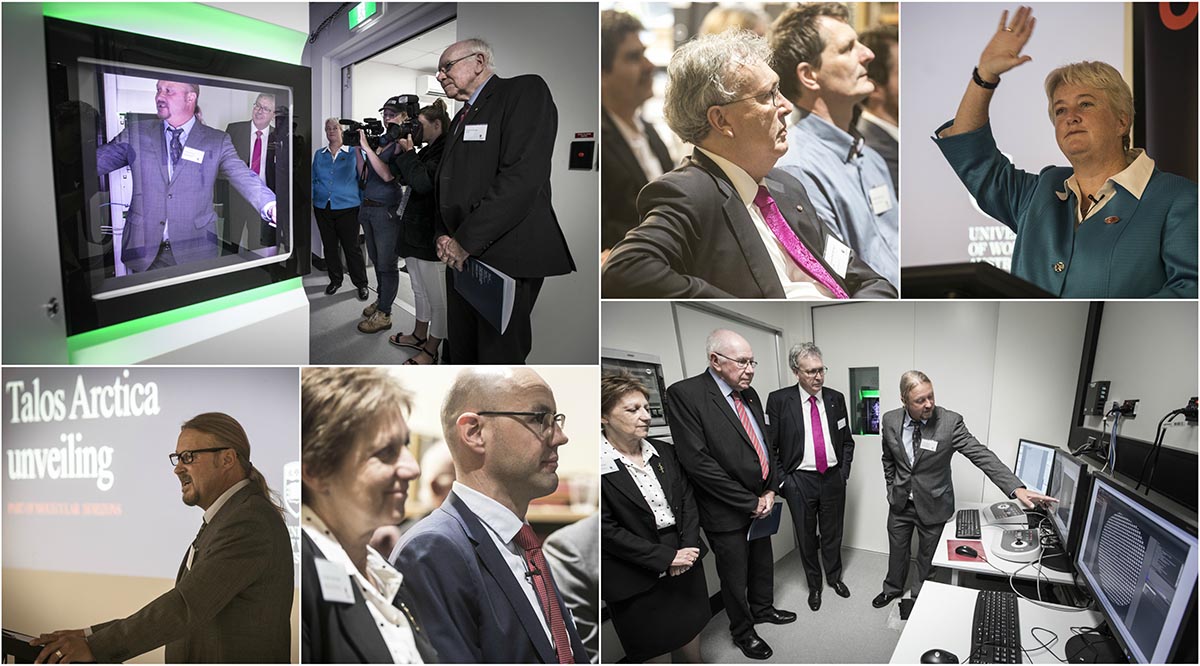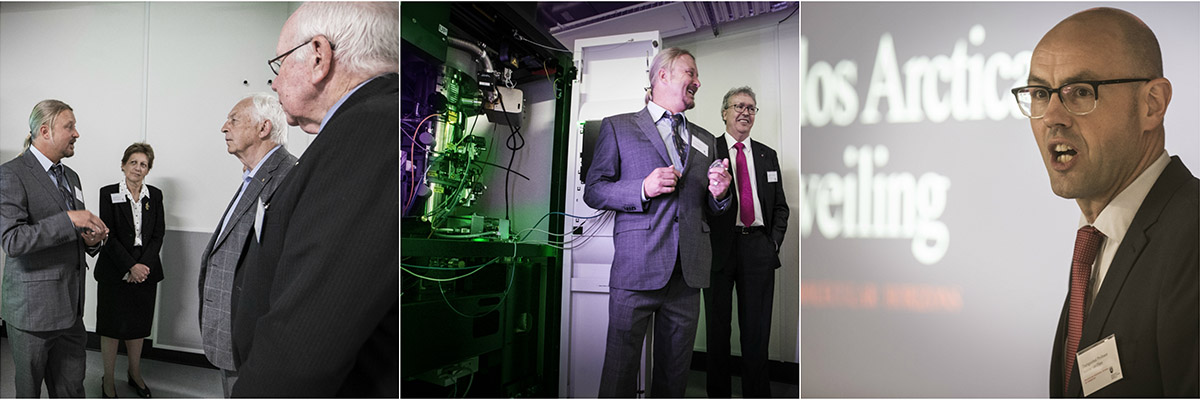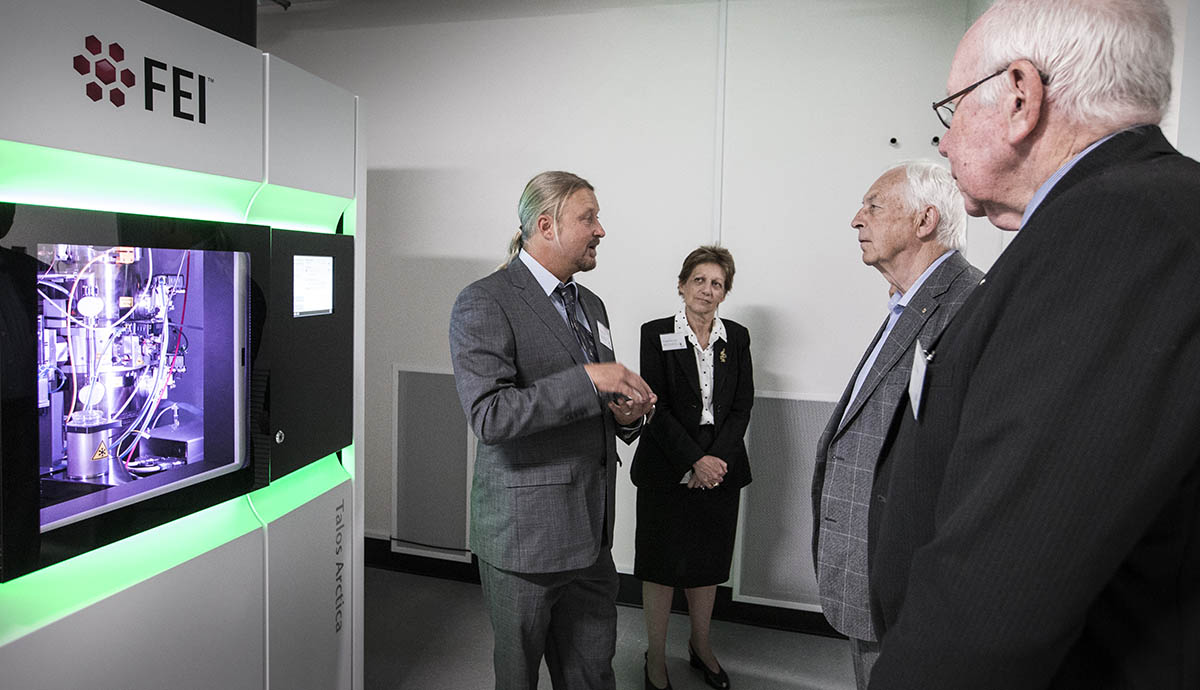December 8, 2017
Powerful new Talos Arctica microscope unveiled
Revolutionary high-resolution microscope will open new doors to fighting disease, understanding the mechanisms of life
The University of Wollongong (UOW) will unveil a powerful new microscope, the FEI Thermo Fisher Talos Arctica, on Friday 8 December.
The Talos Arctica, a high-resolution cryo-electron microscope, is the first of its kind in Australia, and the first of several key pieces of infrastructure that will help make UOW’s $80 million Molecular Horizons a world-leading life-science research centre.
Cryo-electron microscopy (cryo-EM) has revolutionised molecular biology, allowing researchers to see down to an atomic scale, giving them unprecedented clarity on the inner workings of human cells.
By generating three-dimensional visualisations of protein molecules, cryo-EM allows researchers to understand how proteins move and interact over time, opening the door to developing new ways to detect and fight diseases from cancer to Alzheimer’s to antimicrobial resistance.
The Talos Arctica has been installed on the Wollongong campus and is already being used by researchers. It will work in tandem with the even more powerful FEI Thermo Fisher Titan Krios when that microscope begins operating in early 2018.
The Titan Krios will initially be set-up at ANSTO’s Lucas Heights facility, before both machines are moved to the purpose built Molecular Horizons Building when it opens in 2019.
UOW Deputy Vice-Chancellor (Health and Communities) and Executive Dean of the Faculty of Science, Medicine and Health Professor Alison Jones said the installation of the microscope marked a milestone in the realisation of the University’s Molecular Horizons vision.
“The Talos Arctica is the first of many cutting-edge tools which will eventually all be housed in Molecular Horizons – a world-class research facility to be built on this campus and UOW’s largest ever self-funded research infrastructure investment,” Professor Jones said.
“Molecular Horizons will place the University at the forefront of scientific discovery, helping us to understand how life works at a molecular level so we can solve some of the biggest health challenges in the world.
“This rare technology is in demand by researchers not only in NSW but all over the world.”

World-renowned molecular biophysicist Professor Antoine van Oijen, who leads an interdisciplinary team of UOW researchers looking at ways to address antimicrobial resistance, said Molecular Horizons’ cryo-electron microscopes would enable scientists to understand the molecular basis of disease, leading to new cures.
"The Talos Arctica is the very first of its kind in Australia and represents the newest generation of microscopes. It can produce images of cells and proteins that show details fractions of nanometers in size, one million times smaller than the thickness of a human hair,” Professor van Oijen said.
“Using this type of microscopy, we don’t have to rely exclusively on circumstantial evidence to design drug molecules that have to very precisely fit into disease-relevant proteins.
“Taking very precise pictures will provide us with much more direct evidence, knowledge that will accelerate development of new therapies and treatments. Almost like knowing exactly how the inside of a lock looks like so you can design the key instead of having to pick the lock with a paperclip in the dark.
“These powerful microscopes allow us to see at the atomic and molecular level, within single cells, how life works and what molecules inside cells are doing. That information can then be translated into actual drugs and actual therapeutic strategies.”
Senior Manager of Cryo-Electron Microscopy Dr James Bouwer said Molecular Horizons would make UOW a national and international hub for collaborative research using cryo-EM.
“An endeavour of this stature, requires a multi-disciplinary approach, bringing together the skills of clinical researchers, chemists, biologists, physicists, engineers, computer scientists, and mathematicians. As such, teamwork and collaboration is critical,” Dr Bouwer said.
“Molecular Horizons has setup collaborations with many of Australia’s most important research scientists from across the continent. We are working to develop rich relationships with university and research institutions across Australia and Asia in Brisbane, Sydney, Melbourne, Newcastle, Perth, New Zealand, and Singapore. Additionally, we are continuing to develop new partnerships with academic and industry partners around the world.
“My aim here is to put together a world-class facility. One of the critical components is of course the microscopes, the first of which, the Talos Arctica, is now operating. This microscope can visualise proteins at data rates and resolution that was thought impossible 10 years ago.
“When the Titan Krios microscope is installed at ANSTO in January of 2018, it will take high-resolution structures from the Arctica and move them to the next level of resolution, where structures are resolved to a little more that the diameter of a hydrogen atom.
“What this means is that we now have the capability of looking into the molecular machinery of life to understand disease processes such as HIV/AIDS, Parkinson’s disease, Alzheimer’s disease, cancers, and other forms of ill health, thereby providing opportunities to intelligently intervene with drug treatments and stop, or even, reverse disease.”

UOW HEALTH AND WELLBEING STRATEGY
Molecular Horizons is the centrepiece of UOW’s Health and Wellbeing Strategy, which includes a raft of initiatives aimed at harnessing UOW’s expertise in medical research, research application and education to address regional and global health challenges.
Professor Jones sees the University’s investment in Molecular Horizons as a key enabler for building partnerships.
“Through the Health and Wellbeing Strategy UOW will harness and build upon the collective talent across the University and our partners and communities to improve physical and mental wellbeing for our regional and state communities,” Professor Jones said.
“At the core of the strategy is our endeavour to develop health models that support open access, so everyone has the opportunity to improve their state of health. UOW aims to deliver world-class health and medical research, research translation, education and health outcomes and use them to lead and inform world’s best practice.
“UOW is a leader in health research and education and we are pursuing a partnership approach to deliver this package of initiatives because we know that it is by collaboration that we can make a difference.
“The Talos Arctica microscope will certainly make a difference by providing the technology to deliver personalised medicine. We are proud to lead the way for a national approach on breakthroughs in molecular science through technology, research and industry collaborations.”
